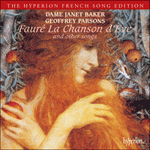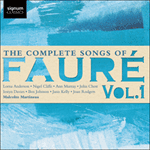Fauré begins his song-writing career with a pianistic
carte de visite. A ritornello is launched with élan (one ascending C major scale, then another – a musical commonplace adapted for lepidopteran acrobatics) followed by sequences that spiral downwards in waltz rhythm. The song is usually chattered in a fast tempo (and in a bright D major transposition) that emphasizes its glittering superficiality. In the lower, original, key there is room for a touch of sadness and vulnerability; we can see a lovesick teenager rooted to the spot and not yet able to quench the thirsts of adolescence. The cover of the autograph (where the composer takes more pains in the penmanship of the title,
La fleur et le papillon, than in the setting’s prosody) contains an amusing sketch of a flower with tiny arms looking up to a hovering butterfly wearing a crown. This was drawn by Saint-Saëns, Fauré’s teacher at the École Niedermeyer, who was clearly bemused by his pupil’s achievement. The poem, No XXVII in Hugo’s
Chants du crépuscule has no title in the first edition. Perhaps the composer knew the text from Henri Reber’s modest setting of 1847.
from notes by Graham Johnson © 2005
C’est avec cette carte de visite pianistique que Fauré débute sa carrière de mélodiste. Un ritornello, lancé avec élan (une gamme d’ut majeur ascendante, puis une autre—un lieu commun musical adapté aux acrobaties des lépidoptères), précède des séquences descendant en spirale, dans un rythme de valse. La mélodie est globalement babillée dans un tempo rapide (et dans une éclatante transposition en ré majeur), qui accuse sa scintillante superfacialité. Plus basse, la tonalité originale est davantage délicate et autorise un soupçon de tristesse, de vulnérabilité ; on imagine un adolescent malade d’amour, cloué sur place, encore incapable d’étancher les soifs de son âge. La couverture du manuscrit autographe (où le compositeur s’attache plus à la calligraphie du titre,
La fleur et le papillon, qu’à la prosodie de la mise en musique) présente une amusante esquisse de fleur avec des bras minuscules, qui regarde un papillon couronné voleter au-dessus d’elle. Ce dessin est de Saint-Saëns, professeur de Fauré à l’École Niedermeyer, qui fut manifestement déconcerté par la réalisation de son élève. Le poème (le no XXVII des
Chants du crépuscule de Hugo) est sans titre dans l’édition princeps. Peut-être Fauré le découvrit-il grâce à la modeste mise en musique d’Henri Reber (1847).
extrait des notes rédigées par Graham Johnson © 2005
Français: Hypérion


 Fauré: La chanson d'Ève & other songs
Fauré: La chanson d'Ève & other songs Fauré: The Complete Songs, Vol. 1
Fauré: The Complete Songs, Vol. 1
